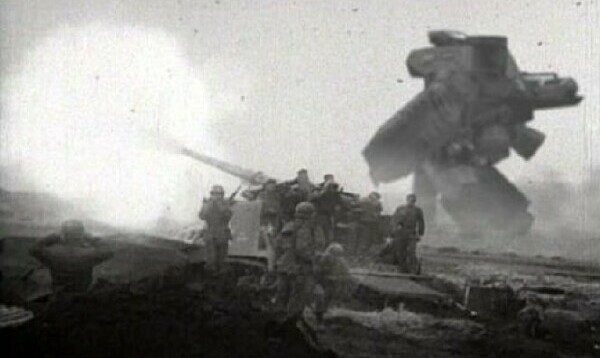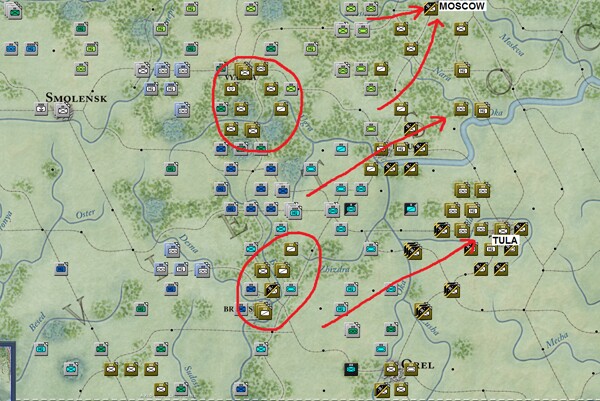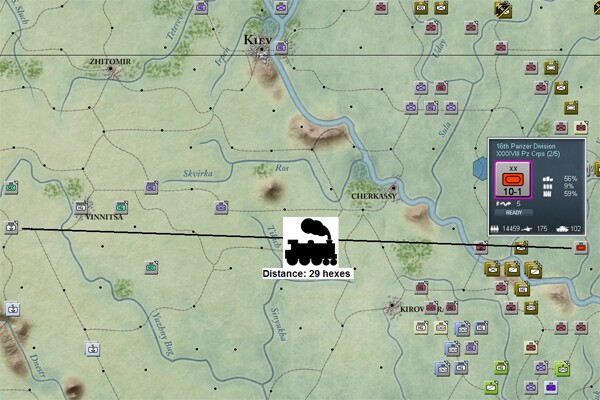
2011 is the 70th anniversary of the launching of the final German drive on Moscow, Operation Typhoon (in German: Taifun). And it’s the 70th anniversary of the invasion of Russia itself, obviously. Don’t bogart my point, which is that this game diary entry is about Operation Typhoon. It’s probably one of the most significant battles in the history of the world, and some would argue that the outcome was decided before it started. Others would argue that it didn’t have to happen at all. The latter group would be wargamers.
Operation Typhoon was, in a sense, the Germans’ second choice. The Germans had the opportunity to drive directly for Moscow after the successful conclusion of the Smolensk encirclement battle in August. Hitler’s decision to instead make Leningrad and the Ukraine primary objectives and to turn Guderian’s panzers south (referred to ad nauseam in this game diary as the “right turn”) set the rest of the campaign on a course with possibly only one conclusion.
The Germans launched Operation Typhoon on 2 October 1941 (although Guderian’s Panzer Group 2 jumped off a few days earlier). Hitler had also transferred Hoepner’s Panzer Group 4 from Army Group North to Army Group Center, concentrating three panzer groups for a drive on Moscow.
My version of Operation Typhoon starts on 28 August, which is Turn 11. That’s over a month earlier than the historical date, but just like in real life, I immediately surround two pockets around Vyazma and Bryansk. My encirclements yield only 110,000 prisoners, but it’s still a good start. I’ve put myself in a bit of a bind, though, by driving straight for Moscow from Smolensk, which allowed the Soviets to establish a strong east-west defensive line just south of Rzhev. This means that in my game, there will be no northern pincer through Kalinin. This allows Soviets to concentrate their defenses. I duplicate the historical plan in the south by sending Guderian up from the south through Tula to hook northeast, since Tula is a victory point city. It’s still a long way to go.

But the focus on Moscow presupposes that capturing that city would have somehow won the war. Even older texts acknowledge this is probably not true. Col. Albert Seaton wrote a decent book, entitled Battle for Moscow, back in 1971, when the Soviet archives were still closed and most Eastern Front scholarship was still based on German sources. I took it off the shelf recently and re-read most of it. In it, he makes a pretty spectacular claim.
The root of the German failure lay primarily in timing. If Hitler had listened to his professional advisors during July and August and had continued the Army Group Center offensive along the Smolensk-Moscow axis, instead of diverting his forces to Leningrad and Kiev, nothing could have saved the Soviet capital. In all probability he would have been able to extend his conquests to Yaroslavl and a line 150 miles beyond Moscow, but to have done this he would have had to forego his great victory at Kiev. The eastern Ukraine would have remained unconquered. But even then should he have reached the line 150 miles beyond the capital, the war would not have been won. In any case it is doubtful whether, having secured such a line before the arrival of the bad weather, German troops could have held it successfully during the winter months.
Counter-factual history is a risk-free business. You can’t ever prove anything, but no one can prove you wrong, either. It’s the kind of airy, speculative indulgence that finds a perfect home on message boards and in wargaming essays. Wargames themselves are fundamentally counter-factual history tools. Not that they prove or disprove anything, either. But they make the history somewhat more tangible, so that “150 miles beyond Moscow” is more than just a vague idea. It’s exactly 15 hexes that way.
Everything I have read about the Eastern Front in 1941, including those sources quoted here, attributes the failure of the German invasion in large part to logistical problems. I’ve quoted David Glantz extensively in this game diary regarding difficulties with the German rail net. But nothing is as tangible as a picture of a square with some numbers in it, on a grid of hexagons. So here’s that.

It’s an illustration of the issues I’m facing, and therefore by direct wargaming corollary, the exact problems faced by real life commanders in real life history times. It may be a little hard to tell, but that’s 16th Panzer Division, part of 48th Panzer Corps. Each unit receives supply, fuel, and ammo, and this is displayed whenever you select that unit. If you squint really hard, you can see that 16th Panzer is currently receiving 9% of its required fuel. Because War in the East is War in the East, I cannot with absolute certainty tell you why this is. However, I suspect it is related to the fact that I am very, very far from my railheads. In this particular case, 29 hexes. That’s almost 300 miles. A fully supplied, fully fuelled panzer division has a movement allowance of 50. My panzer divisions in Army Group South have movement allowances between 8 and 10. My infantry divisions move faster than this. The slow going in the south (due to the strong forces deployed by the Soviet Southwest Front) held back my rail conversion efforts, and after finally breaking out east of Kiev, my rail engineers couldn’t keep up.
I’m trapped by my commitment to the south, though, because of the victory conditions which place so much emphasis on the victory point cities of Kiev, Kharkov, Stalino, and Rostov. As I pointed out in my diary on victory conditions, without positive victory point gains, it doesn’t matter how many victory points I deny the Soviets. I get no positive victory point benefit for capturing Leningrad or Moscow.
But I get a huge positional benefit, especially for Leningrad. The problem is, it doesn’t pay off until 1942. And I’m playing the 1941 scenario.
Alan Clark wrote Barbarossa: The Russian-German Conflict, 1941-45 way back in 1965. It’s probably one of the most readable single-volume histories of the war in the east. It also produces claims like this.
The probable outcome of a direct thrust on Moscow has already been discussed. It remains to be said that had the generals accepted Hitler’s orders and put themselves wholeheartedly into the preparation of an immediate drive on Leningrad, that city would probably have fallen by the end of August.
I was going to do another game diary entry on Leningrad, and may still do so if it fits, because statements like this are much more historically pointed than endless speculation about Moscow. Of the major cities in Eastern Front wargames, Leningrad is often one of the least vulnerable, because it can usually only be attacked from a couple of hexes, limiting the number of “combat factors” you can bring to bear as the Germans. But once you capture it, you accrue a whole host of benefits. First of all, you release the Finns, which gets you a fair number of free, valuable combat units. Unlike the Italians, Hungarians, or Rumanians, they are not a liability on the front line. Once the Soviet defense breaks down in the north, it is very hard to re-establish in the face of renewed Finnish activity, especially if as the Germans you fortify the Volkhov River line. Leningrad is a major city, which provides good shelter in the severe winter of 1941-2 in games which have rules for that. It’s all very fascinating from a counter-factual history standpoint.
And from a wargame perspective, it’s often very effective. You can redeploy most of your strength to the center and south, and if you make it through the winter, your 1942 spring offensive can concentrate on Moscow. If you capture that, you’ve pretty much won the game. By contrast, Moscow is subject to fierce winter counterattacks if you take it in 1941, and if Leningrad is enemy-held, you have to worry about the north as well.
So most wargames got over the obsession with Moscow long ago. The problem with the Operation Barbarossa scenario in War in the East is that it ends in early December 1941, and judges you on the objectives the Germans set historically, rather than counter-factual suppositions. It’s an incredibly high bar to reach, and given historical conditions, might not have been achievable. But it’s the standard on which I’ll be judged at the end of Turn 24. Maybe I should have tried the grand campaign game instead.
Discussion
No comments yet.